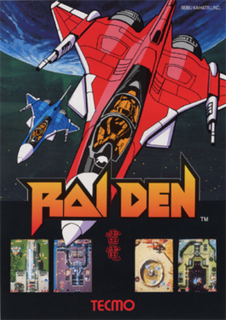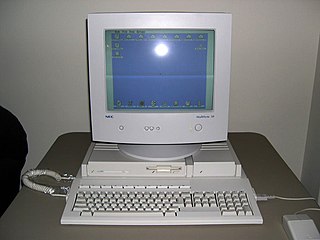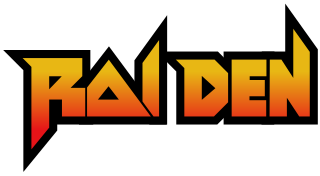
The Atari 7800 ProSystem, or simply the Atari 7800, is a home video game console officially released by Atari Corporation in 1986 as the successor to both the Atari 2600 and Atari 5200. It can run almost all Atari 2600 cartridges, making it one of the first consoles with backward compatibility. It shipped with a different model of joystick from the 2600-standard CX40 and Pole Position II as the pack-in game. Most of the announced titles at launch were ports of 1980–83 arcade video games.

The Atari Lynx is a hybrid 8-bit and 16-bit handheld game console released by Atari Corporation in September 1989 in North America, and in Europe and Japan in 1990.

The Neo Geo, stylised as NEO•GEO and also written as NEOGEO, is a cartridge-based arcade system board and fourth-generation home video game console released on April 26, 1990, by Japanese game company SNK Corporation. It was the first system in SNK's Neo Geo family. The Neo Geo was marketed as 24-bit; its CPU is technically a 16/32-bit 68000-based system with an 8-bit Z80 coprocessor, while its GPU chipset has a 24-bit graphics data bus.

A coprocessor is a computer processor used to supplement the functions of the primary processor. Operations performed by the coprocessor may be floating-point arithmetic, graphics, signal processing, string processing, cryptography or I/O interfacing with peripheral devices. By offloading processor-intensive tasks from the main processor, coprocessors can accelerate system performance. Coprocessors allow a line of computers to be customized, so that customers who do not need the extra performance do not need to pay for it.

The X68000 is a home computer created by Sharp Corporation. It was first released in 1987 and sold only in Japan. Gaming was a major use of the X68000, with custom sprite hardware and an 8-channel sound chip enabling ports of contemporaneous arcade video games.

Raiden is a 1990 vertically scrolling shooter arcade video game developed by Seibu Kaihatsu and published by Tecmo in Japan. The game's story takes place in the year 2090, when an alien species known as the Crystals invaded Earth. Players assume the roles of the Vanquish Crystal Defense pilot duo, taking control of two state of the art Fighting Thunders aircraft to defeat the Crystals and save the Earth.

The Atomiswave is a custom arcade system board and cabinet from Sammy Corporation. It is based on Sega's Dreamcast console, sharing similarities with the NAOMI, as far as it uses interchangeable game cartridges, as well as a removable module for changing the control scheme, but unlike the NAOMI, the Atomiswave doesn't feature expanded RAM compared to the Dreamcast.
The CP System II or CPS-2 is an arcade system board that Capcom first used in 1993 for Super Street Fighter II. It was the successor to their previous CP System and Capcom Power System Changer arcade hardware and was succeeded by the CP System III hardware in 1996, of which the CPS-2 would outlive by over four years. The arcade system had new releases for it until the end of 2003, ending with Hyper Street Fighter II.
The CP System III or CPS-3 is an arcade system board that was first used by Capcom in 1996 with the arcade game Red Earth. It was the second successor to the CP System arcade hardware, following the CP System II. It would be the last proprietary system board Capcom would produce before moving on to the Dreamcast-based Naomi platform.

The Super FX is a coprocessor on the Graphics Support Unit (GSU) added to select Super Nintendo Entertainment System (SNES) video game cartridges, primarily to facilitate advanced 2D and 3D graphics. The Super FX chip was designed by Argonaut Games, who also co-developed the 3D space rail shooter video game Star Fox with Nintendo to demonstrate the additional polygon rendering capabilities that the chip had introduced to the SNES.

Seibu Kaihatsu Inc. was a Japanese manufacturer of arcade games. The company was founded in 1982 at Chiyoda-ku, Tokyo, Japan as Seibu Denshi Inc. (有限会社セイブ電子), but changed to its current name sometime in 1984. It is currently owned by Hitoshi Hamada.

The Atari TT030 is a member of the Atari ST family, released in 1990. It was originally intended to be a high-end Unix workstation, but Atari took two years to release a port of Unix SVR4 for the TT, which prevented the TT from ever being seriously considered in its intended market.
Raiden Fighters 2: Operation Hell Dive is a 1997 scrolling shooter arcade game by Seibu Kaihatsu. It is the direct sequel to Raiden Fighters, which is a spin-off of the Raiden scrolling shooter video game franchise. This game shares the same game mechanics as its predecessor while expanding on the concepts that defined it. It is followed by Raiden Fighters Jet, the third game in the series.
The Taito Type X is an arcade system board released in 2004 by game developer and publisher Taito.

Viper Phase 1 is a 1995 scrolling shooter arcade game by Seibu Kaihatsu. It is a spin-off in the Raiden series set in space.

Raiden is a series of arcade games by Seibu Kaihatsu initially available in arcades in Japan and later distributed to other countries by Fabtek and other arcade game manufacturers.

SGI Onyx is a series of visualization systems designed and manufactured by SGI, introduced in 1993 and offered in two models, deskside and rackmount, codenamed Eveready and Terminator respectively. The Onyx's basic system architecture is based on the SGI Challenge servers, but with graphics hardware.
Atari System refers to two arcade system boards introduced in 1984 for use in various arcade games from Atari Games. Two versions of the board were released, Atari System 1 and Atari System 2.
The IGEPv2 board is a low-power, fanless single-board computer based on the OMAP 3 series of ARM-compatible processors. It is developed and produced by Spanish corporation ISEE and is the second IGEP platform in the series. The IGEPv2 is open hardware, licensed under a Creative Commons Attribution-Non Commercial-ShareAlike 3.0 unported license.













